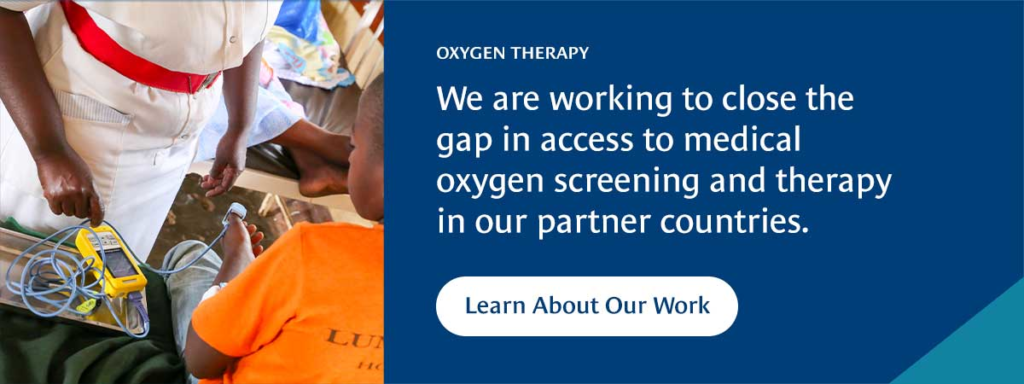In Ethiopia, pneumonia accounts for 18 percent of all child deaths. Hypoxemia, or low blood oxygen, is a common and deadly complication of pneumonia. Medical oxygen is the only treatment.
However, access to both oxygen and pulse oximeters, handheld devices used to diagnose hypoxemia, are limited in many African countries, including Ethiopia. A 2015 assessment of more than 100 hospitals in Ethiopia showed that only 45 percent of in-patient pediatric departments had access to pulse oximeters, while 63 percent of departments had oxygen. Further review showed there were significant issues with the use of oxygen in clinical practice which needed immediate interventions.
CHAI began working with the Ministry of Health at the end of 2015 to address these issues. Our program focused on improving oxygen services at public hospitals in Ethiopia. We took a multifaceted approach that included developing new policies and guidelines, procuring oxygen equipment and pulse oximeters, and training health workers to better diagnose and treat hypoxemia.
The program transformed access to this life-saving medicine in pediatric wards across public hospitals. By 2019 oxygen was available in 100 percent and pulse oximeters in 96 percent of in-patient pediatric departments where the program ran. Clinical practice also improved with pulse oximeter use at diagnosis increasing from 10.2 percent to 75 percent. The results were recently published in BMC Pediatrics.
Then the pandemic hit. Demand for oxygen far exceeded Ethiopia’s prior goals. The country had the fourth highest COVID-19 caseload in Africa and eight in ten patients struggled to access oxygen.
The investments the country already made to address oxygen shortages gave Ethiopia a head start. COVID treatment centers were set up in facilities that had received oxygen equipment in the last three years. Policies and treatment guidelines for better hypoxemia management provided a foundation for COVID-19 treatment, and thousands of health workers were already well versed in oxygen treatments. These investments saved lives in the early months of the pandemic.
For now, COVID-19 is in retreat, with the average number of daily new infections dropping by more than 400 over the last three weeks, according to Reuters. That puts the infection rate at 20 percent of its previous peak. With the decline, oxygen needs are also falling.
This doesn’t mean our work is finished. The program we started with the Ministry of Health in 2016 continues. Equipment maintenance, training, and clinical mentoring are key to driving even broader access to oxygen in the country. Until COVID-19 vaccines become widely available, oxygen remains critical to saving the lives of those who are severely ill. Tens of thousands of others throughout the health system continue to require oxygen – and will require it long after this pandemic. These include newborns, pregnant women, and surgical patients, as well as the patients we first targeted with this program: children with pneumonia.






